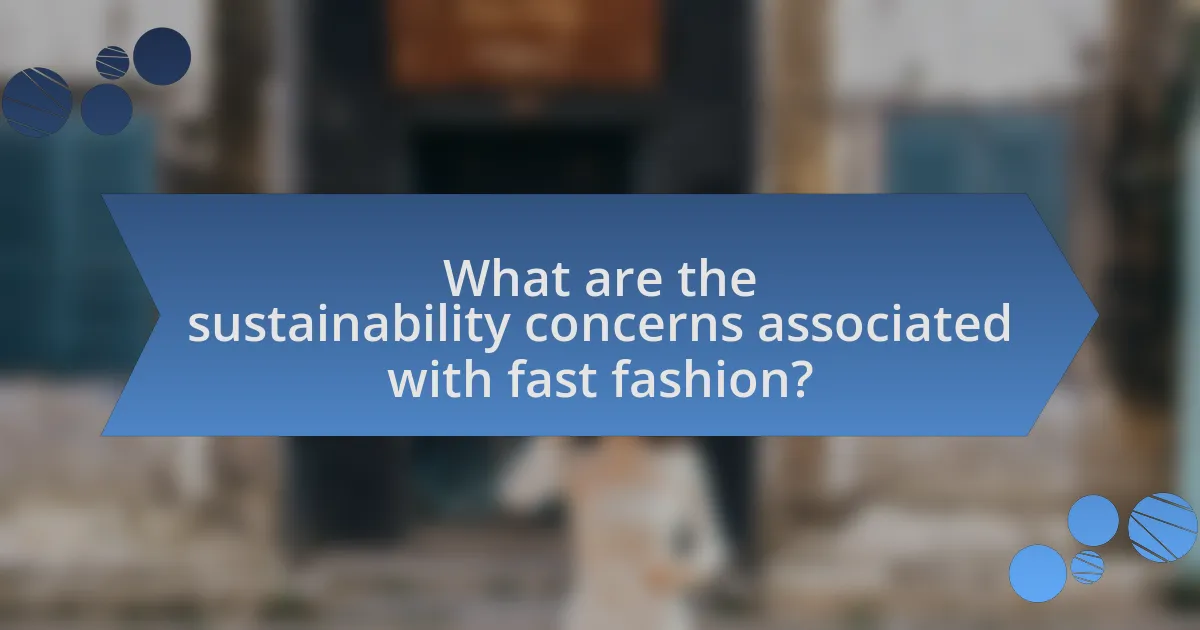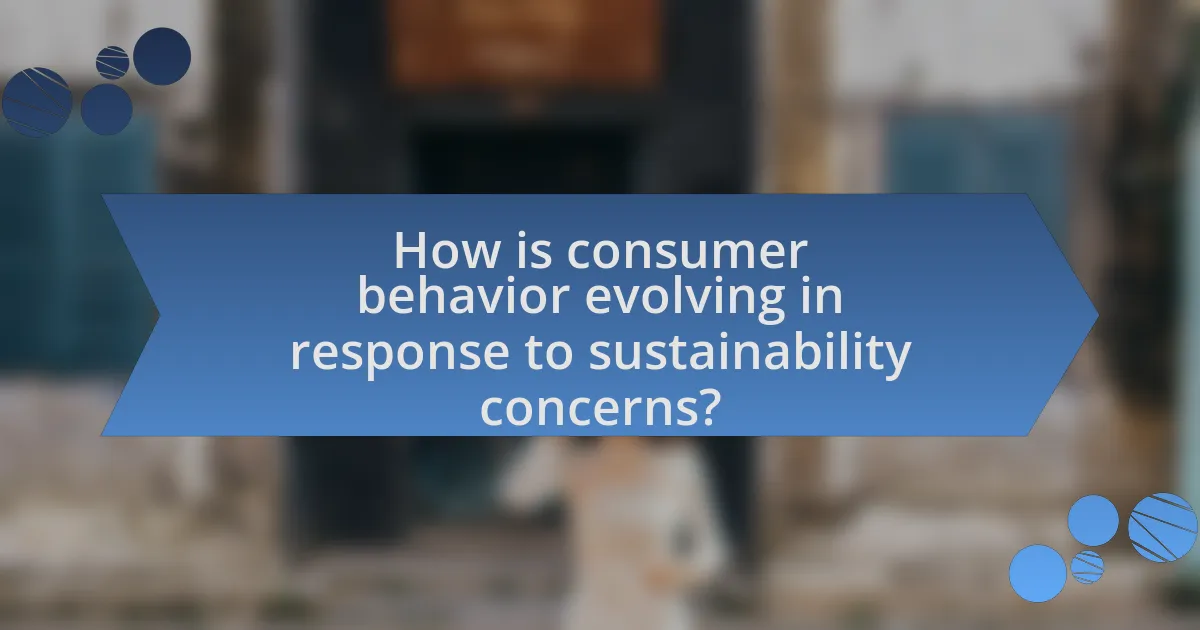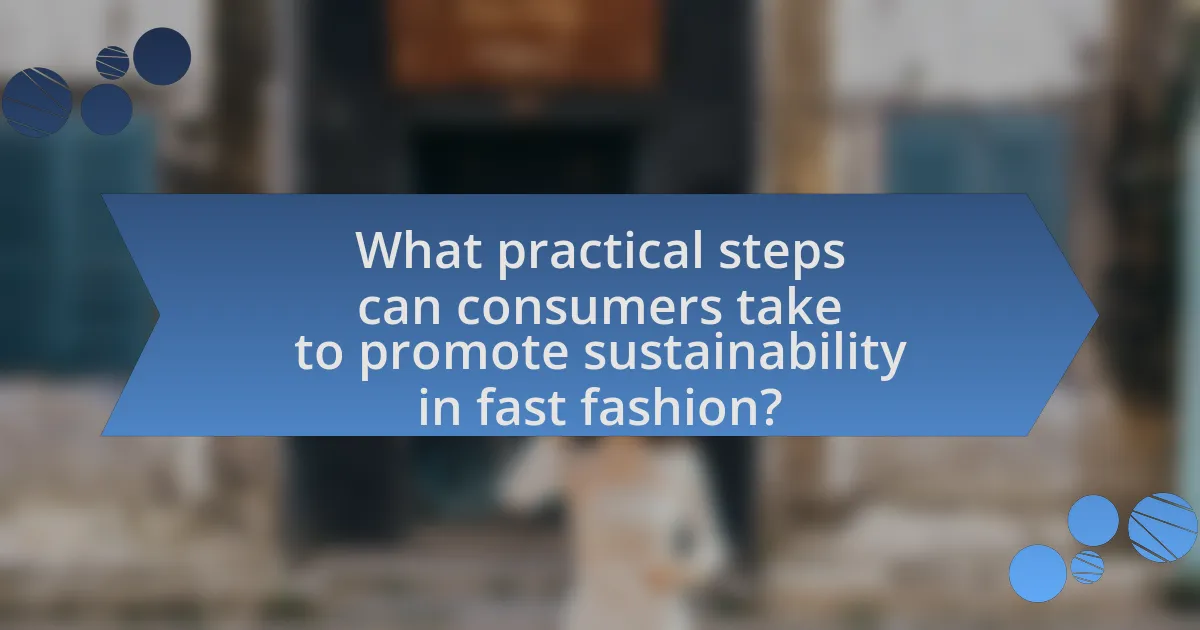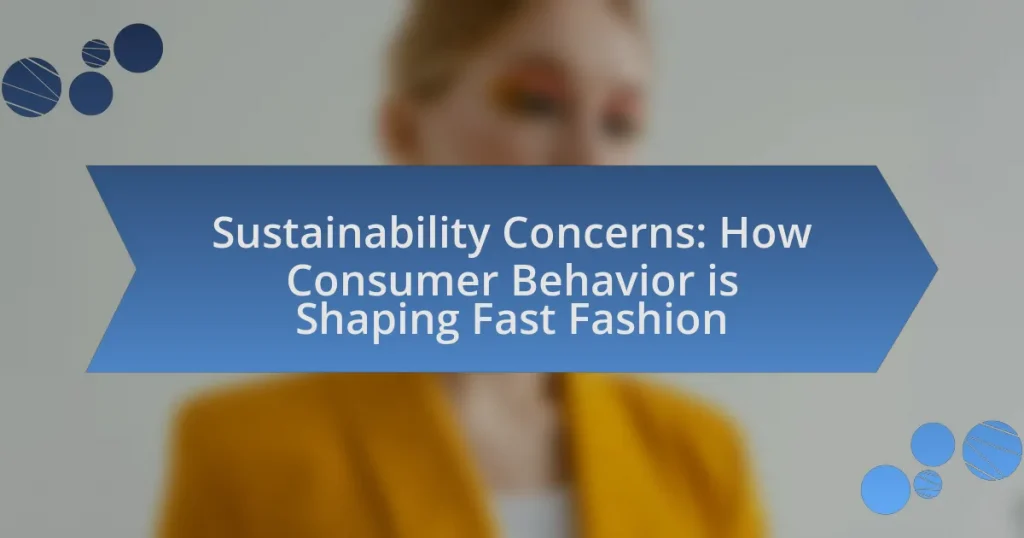The article focuses on the sustainability concerns associated with fast fashion, highlighting its significant environmental impact and unethical labor practices. It details how fast fashion contributes to pollution, waste generation, and resource depletion, with the industry responsible for approximately 10% of global carbon emissions and 92 million tons of textile waste annually. Additionally, the article examines the social implications of fast fashion, including labor exploitation and poor working conditions in developing countries. It emphasizes the crucial role of consumer behavior in promoting sustainable practices, noting the shift towards eco-friendly choices and the demand for transparency in supply chains. The article also outlines practical steps consumers can take to support sustainability in fashion, such as prioritizing second-hand shopping and choosing ethical brands.

What are the sustainability concerns associated with fast fashion?
Fast fashion raises significant sustainability concerns primarily due to its high environmental impact and unethical labor practices. The production processes often involve the use of toxic chemicals, excessive water consumption, and significant carbon emissions; for instance, the fashion industry is responsible for about 10% of global carbon emissions. Additionally, fast fashion promotes a culture of disposability, leading to massive amounts of textile waste; approximately 92 million tons of textile waste are generated annually. Furthermore, labor exploitation is prevalent, with many workers in developing countries facing poor working conditions and low wages. These factors collectively highlight the urgent need for more sustainable practices in the fashion industry.
How does fast fashion impact the environment?
Fast fashion significantly impacts the environment by contributing to pollution, waste, and resource depletion. The production of fast fashion garments often involves toxic chemicals, which can contaminate water sources and harm ecosystems. For instance, the fashion industry is responsible for 20% of global wastewater, primarily due to dyeing processes. Additionally, fast fashion encourages a throwaway culture, leading to approximately 92 million tons of textile waste generated annually, much of which ends up in landfills. Furthermore, the rapid production cycles require vast amounts of natural resources, with the industry consuming around 93 billion cubic meters of water each year, exacerbating water scarcity issues. These factors collectively illustrate the detrimental environmental consequences of fast fashion.
What are the main environmental issues caused by fast fashion?
The main environmental issues caused by fast fashion include excessive waste generation, water pollution, and high carbon emissions. Fast fashion brands produce millions of garments annually, leading to approximately 92 million tons of textile waste each year, as reported by the Ellen MacArthur Foundation. Additionally, the production processes often involve toxic chemicals that contaminate water sources, with the World Bank estimating that 20% of global industrial water pollution comes from textile dyeing and treatment. Furthermore, fast fashion contributes significantly to climate change, accounting for about 10% of global carbon emissions, according to the United Nations Environment Programme.
How does fast fashion contribute to waste and pollution?
Fast fashion contributes to waste and pollution primarily through the rapid production and disposal of clothing. The industry produces approximately 92 million tons of textile waste annually, with a significant portion ending up in landfills. Additionally, the manufacturing processes involve the use of toxic chemicals and dyes, which can contaminate water sources. For instance, the production of a single cotton shirt requires about 2,700 liters of water, exacerbating water scarcity issues. Furthermore, fast fashion’s reliance on synthetic fibers, such as polyester, leads to microplastic pollution, with an estimated 500,000 tons of microfibers entering oceans each year. These factors collectively highlight the detrimental environmental impact of fast fashion on waste generation and pollution.
What social implications arise from fast fashion practices?
Fast fashion practices lead to significant social implications, including labor exploitation and environmental degradation. The industry often relies on low-wage labor in developing countries, where workers face poor working conditions, long hours, and minimal rights. For instance, a report by the International Labour Organization highlights that garment workers in countries like Bangladesh earn as little as $95 per month, far below a living wage. Additionally, fast fashion contributes to a culture of consumerism that prioritizes quantity over quality, fostering a throwaway mentality that exacerbates waste and environmental harm. According to the Ellen MacArthur Foundation, the fashion industry is responsible for 10% of global carbon emissions, further impacting social structures by straining community resources and health.
How does fast fashion affect labor conditions in the industry?
Fast fashion negatively impacts labor conditions in the industry by promoting low wages, long working hours, and unsafe working environments. The demand for rapid production cycles forces manufacturers to cut costs, often resulting in exploitation of workers, particularly in developing countries. For instance, a report by the International Labour Organization indicates that garment workers in countries like Bangladesh earn as little as $95 per month, far below the living wage. Additionally, the pressure to meet tight deadlines can lead to unsafe working conditions, as seen in the Rana Plaza disaster in 2013, where over 1,100 workers died due to building collapses linked to poor safety standards. These factors illustrate how fast fashion contributes to systemic labor abuses in the garment industry.
What are the ethical concerns related to fast fashion consumerism?
The ethical concerns related to fast fashion consumerism include exploitation of labor, environmental degradation, and unsustainable consumption practices. Fast fashion brands often rely on low-wage labor in developing countries, where workers face poor working conditions, long hours, and minimal pay, exemplified by reports from organizations like the International Labour Organization, which highlight labor rights violations. Additionally, the fast fashion industry contributes significantly to environmental issues, with the production process generating substantial waste and pollution; for instance, the Ellen MacArthur Foundation states that the fashion industry is responsible for 10% of global carbon emissions. Lastly, fast fashion promotes a culture of disposability, encouraging consumers to buy more than they need and discard items quickly, leading to increased landfill waste and resource depletion.
Why is consumer behavior crucial in addressing sustainability in fast fashion?
Consumer behavior is crucial in addressing sustainability in fast fashion because it directly influences demand for sustainable practices and products. When consumers prioritize eco-friendly options, brands are compelled to adopt sustainable practices to meet this demand. For instance, a study by McKinsey & Company found that 67% of consumers consider the use of sustainable materials important when making fashion purchases. This shift in consumer preferences drives companies to innovate and implement sustainable practices, such as reducing waste and improving supply chain transparency, ultimately leading to a more sustainable fast fashion industry.
How do consumer choices influence fast fashion brands?
Consumer choices significantly influence fast fashion brands by driving demand for trendy, affordable clothing, which compels these brands to rapidly produce new collections. As consumers increasingly prioritize sustainability, brands are responding by adopting eco-friendly practices, such as using recycled materials and improving labor conditions. For instance, a 2021 survey by McKinsey & Company found that 67% of consumers consider sustainability when making a purchase, prompting fast fashion retailers to integrate sustainable practices into their business models to remain competitive. This shift in consumer behavior not only affects product offerings but also shapes marketing strategies, as brands highlight their sustainability efforts to attract environmentally conscious shoppers.
What role does consumer awareness play in promoting sustainable practices?
Consumer awareness plays a crucial role in promoting sustainable practices by influencing purchasing decisions and encouraging brands to adopt environmentally friendly methods. When consumers are informed about the environmental impact of their choices, they are more likely to support companies that prioritize sustainability, leading to increased demand for eco-friendly products. Research indicates that 66% of global consumers are willing to pay more for sustainable brands, demonstrating that awareness directly correlates with consumer behavior. This shift in demand compels businesses to implement sustainable practices, such as reducing waste and utilizing ethical sourcing, to remain competitive in the market.

How is consumer behavior evolving in response to sustainability concerns?
Consumer behavior is evolving towards increased demand for sustainable products and practices in response to sustainability concerns. This shift is evidenced by a growing preference for brands that prioritize eco-friendly materials, ethical labor practices, and transparent supply chains. According to a 2021 survey by McKinsey, 67% of consumers consider sustainability when making purchasing decisions, indicating a significant change in consumer priorities. Additionally, the rise of second-hand shopping and rental services reflects a move away from fast fashion, as consumers seek to reduce waste and environmental impact.
What trends are emerging in consumer preferences regarding fast fashion?
Emerging trends in consumer preferences regarding fast fashion include a significant shift towards sustainability and ethical production practices. Consumers increasingly prioritize brands that demonstrate environmental responsibility, with 66% of global consumers willing to pay more for sustainable products, according to a Nielsen report. Additionally, there is a growing demand for transparency in supply chains, as shoppers seek to understand the origins of their clothing and the labor conditions involved. This trend is further supported by a rise in second-hand shopping and clothing rental services, reflecting a desire for more sustainable consumption patterns.
How are consumers prioritizing sustainability in their purchasing decisions?
Consumers are increasingly prioritizing sustainability in their purchasing decisions by actively seeking eco-friendly products and brands that demonstrate social responsibility. A survey conducted by Nielsen in 2019 revealed that 73% of global consumers are willing to change their consumption habits to reduce environmental impact. This shift is evident in the fast fashion industry, where consumers are favoring brands that utilize sustainable materials, implement ethical labor practices, and promote transparency in their supply chains. Additionally, a report from McKinsey & Company in 2021 indicated that 67% of consumers consider sustainability when making fashion purchases, highlighting a significant trend towards environmentally conscious consumer behavior.
What demographic factors influence sustainable consumer behavior?
Demographic factors that influence sustainable consumer behavior include age, income, education level, and geographic location. Younger consumers, particularly Millennials and Generation Z, tend to prioritize sustainability more than older generations, as evidenced by a 2021 study from McKinsey which found that 67% of consumers aged 18-29 consider sustainability when making purchases. Higher income levels correlate with increased willingness to pay for sustainable products, as reported by Nielsen in 2015, which indicated that 66% of affluent consumers are willing to pay more for sustainable brands. Education also plays a significant role; individuals with higher education levels are more likely to engage in sustainable consumption, as shown in research published in the Journal of Consumer Research, which highlights that educated consumers are more aware of environmental issues. Lastly, geographic location affects sustainable behavior, with urban consumers generally exhibiting more sustainable practices compared to rural consumers, as urban areas often have better access to sustainable products and services.
How are brands responding to changing consumer expectations?
Brands are responding to changing consumer expectations by integrating sustainable practices into their operations and product offerings. For instance, many fast fashion brands are adopting eco-friendly materials, such as organic cotton and recycled polyester, to meet the demand for environmentally responsible products. According to a 2021 McKinsey report, 67% of consumers consider the use of sustainable materials important when making purchasing decisions, prompting brands to prioritize sustainability in their supply chains. Additionally, brands are increasing transparency by providing information about their sourcing and manufacturing processes, which aligns with consumers’ desire for ethical practices. This shift is evident as companies like H&M and Zara have launched sustainability initiatives aimed at reducing waste and promoting circular fashion, reflecting a direct response to evolving consumer values.
What strategies are fast fashion brands adopting to become more sustainable?
Fast fashion brands are adopting strategies such as using sustainable materials, implementing recycling programs, and enhancing supply chain transparency to become more sustainable. For instance, brands like H&M and Zara are increasingly incorporating organic cotton and recycled polyester into their collections, which reduces environmental impact. Additionally, many fast fashion companies are launching take-back schemes that encourage customers to return used clothing for recycling, thereby minimizing waste. Furthermore, brands are improving supply chain transparency by disclosing sourcing practices and labor conditions, which aligns with consumer demand for ethical production. These strategies reflect a growing recognition of sustainability as a critical factor in consumer purchasing decisions.
How effective are these strategies in attracting conscious consumers?
These strategies are highly effective in attracting conscious consumers. Research indicates that 66% of global consumers are willing to pay more for sustainable brands, demonstrating a strong market demand for ethical practices. Additionally, brands that implement transparent supply chains and sustainable materials often see increased customer loyalty and engagement, as conscious consumers prioritize ethical considerations in their purchasing decisions. For instance, a study by Nielsen found that 73% of millennials are willing to pay extra for sustainable offerings, highlighting the effectiveness of these strategies in appealing to this demographic.

What practical steps can consumers take to promote sustainability in fast fashion?
Consumers can promote sustainability in fast fashion by prioritizing second-hand shopping, choosing sustainable brands, and practicing mindful consumption. Second-hand shopping reduces waste and extends the life cycle of clothing, as evidenced by the growing popularity of thrift stores and online resale platforms, which have seen a 25% increase in sales over the past five years. Choosing sustainable brands that use eco-friendly materials and ethical labor practices supports responsible production methods; for instance, brands certified by organizations like Fair Trade or GOTS (Global Organic Textile Standard) adhere to strict environmental and social criteria. Practicing mindful consumption involves buying only what is necessary and caring for garments to prolong their use, which can significantly reduce the average consumer’s clothing footprint, estimated at 82 pounds of textile waste per person annually in the U.S.
How can consumers make more sustainable fashion choices?
Consumers can make more sustainable fashion choices by prioritizing brands that use eco-friendly materials and ethical production practices. Research indicates that the fashion industry is responsible for 10% of global carbon emissions, highlighting the importance of selecting sustainable options. By choosing clothing made from organic cotton, recycled materials, or sustainable fabrics like Tencel, consumers can reduce their environmental impact. Additionally, supporting brands that ensure fair labor practices and transparency in their supply chains contributes to ethical consumption. Engaging in second-hand shopping and clothing swaps further minimizes waste, as the average American throws away 81 pounds of clothing annually. These actions collectively promote a more sustainable fashion ecosystem.
What alternatives to fast fashion can consumers consider?
Consumers can consider sustainable fashion brands, thrift shopping, and clothing rental services as alternatives to fast fashion. Sustainable fashion brands prioritize ethical production practices, using eco-friendly materials and fair labor conditions, which reduces environmental impact. Thrift shopping promotes the reuse of clothing, extending the lifecycle of garments and minimizing waste. Clothing rental services allow consumers to access high-quality fashion without the commitment of purchase, further reducing consumption and promoting a circular economy. These alternatives collectively contribute to a more sustainable approach to fashion consumption.
How can consumers support ethical brands and practices?
Consumers can support ethical brands and practices by prioritizing purchases from companies that demonstrate transparency, sustainability, and fair labor practices. Research indicates that 66% of global consumers are willing to pay more for sustainable brands, highlighting a growing demand for ethical consumption. By choosing products from brands that provide clear information about their sourcing, production methods, and labor conditions, consumers can drive market demand towards more responsible practices. Additionally, supporting local businesses and participating in initiatives that promote ethical standards further reinforces the shift towards sustainability in the fashion industry.
What resources are available for consumers to educate themselves on sustainable fashion?
Consumers can educate themselves on sustainable fashion through various resources, including online platforms, books, documentaries, and organizations dedicated to sustainability. Websites like Fashion Revolution and Good On You provide insights into ethical brands and practices. Books such as “Fashionopolis” by Dana Thomas and “The Sustainable Fashion Handbook” by Sandy Black offer in-depth knowledge about the industry. Documentaries like “The True Cost” highlight the environmental and social impacts of fast fashion. Additionally, organizations like the Sustainable Apparel Coalition and the Ellen MacArthur Foundation offer reports and guidelines on sustainable practices in the fashion industry. These resources collectively empower consumers to make informed choices regarding sustainable fashion.
Where can consumers find information on sustainable fashion brands?
Consumers can find information on sustainable fashion brands through various online platforms, including dedicated websites, social media, and sustainability-focused databases. Websites like Good On You provide ratings and reviews of fashion brands based on their sustainability practices, while platforms such as Eco Warrior Princess and The Good Trade offer articles and guides on ethical fashion choices. Additionally, social media channels, particularly Instagram and Pinterest, feature influencers and brands that promote sustainable fashion, making it easier for consumers to discover eco-friendly options. Research indicates that 66% of global consumers are willing to pay more for sustainable brands, highlighting the growing demand for accessible information in this sector.
What tools can help consumers track their fashion consumption and impact?
Tools that can help consumers track their fashion consumption and impact include apps like Good On You, which rates brands based on their sustainability practices, and Buycott, which allows users to scan barcodes to learn about a product’s ethical and environmental impact. Additionally, platforms like Closet+ enable users to catalog their wardrobe and analyze their purchasing habits, promoting mindful consumption. Research indicates that using such tools can lead to more informed purchasing decisions, ultimately reducing the negative environmental effects associated with fast fashion.















